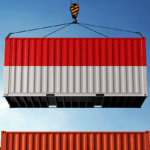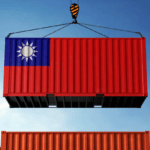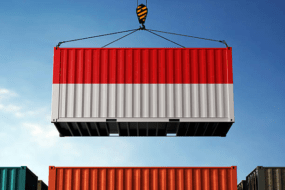- Home
- Trade News
- Taiwan Exports: Hitting Record ...

In an increasingly global landscape, few economies are merely staying afloat but sailing ahead at full steam. Taiwan is one of them. The island has pulled off an extraordinary feat against inflation jitters, tariff threats, and geopolitical unease: Taiwan’s exports have hit record highs for 19 straight months.
Far from slowing down, Taiwan’s export sector is accelerating, driven by surging demand for electrical machinery, semiconductors, and other high-value electronics. This export momentum, seen across established and emerging markets, signals more than a short-term spike.
But as geopolitical winds shift and economic uncertainties mount, will this upward streak endure, or are darker clouds looming just beyond the horizon?
Tech Exports Driving Upward Trends
Taiwan’s momentum has only accelerated in 2025. Export orders hit a fresh May record of US$57.93 billion, up 18.5% year-on-year, as insatiable global demand for AI servers, networking gear, and display cards lifted information-and-communication orders to US$18.2 billion.
Electronics fared even better: orders for semiconductors and high-performance boards surged to US$21.57 billion, a 27.7% jump, underlining how deeply the island now sits at the heart of the AI-driven supply chain.
That strength, however, is increasingly two-speed. Orders for traditional lines such as chemicals and plastics fell more than 14%, squeezed by China’s overcapacity and soft downstream demand.
With a 90-day U.S. tariff truce expiring in July and firms signalling thinner pipelines for June, even Taiwan’s powerhouse electrical machinery sector faces a choppier second half, making diversification and policy agility more critical than ever.
Taiwan Exports to the US
Over the past year, Taiwan’s exports to the United States have emerged as a major growth engine. Amid ongoing friction with mainland China, the US has actively diversified its supply chains, and Taiwan is increasingly viewed as a trusted partner.
Pushing Forward Amidst Uncertainty
Despite looming trade policy changes in Washington, the mood in Taipei remains largely upbeat. Taiwan’s new President, Lai Ching-te, recently reaffirmed his commitment to deepening the country’s economic ties with the US, describing the bilateral trade relationship as “resilient and forward-looking.”
This optimism is not unfounded. Recent data shows strong demand for Taiwanese-made semiconductors, smart manufacturing components, and other industrial goods, all areas where the Republic of China holds strategic advantages.
Interestingly, it’s not just high-tech goods flowing out of Taiwan. The US also sees Taiwan as a valuable export market, especially for predominantly agricultural commodities.
Taiwan Exports to China
Taiwan’s cross-strait commerce has taken an unexpected turn. Far from sliding, exports to mainland China and Hong Kong rebounded in the latest tally to US$ $14.06 billion, up 16.6 % and now 27.2 % of total exports.
That bounce highlights how, despite political strain, sheer market size continues to pull Taiwanese goods across the strait, even as Taipei courts the United States and other partners for longer-term security.
Yet the numbers also expose a strategic dilemma. Beijing still matters, but with tariff uncertainty hanging over the year’s second half, many Taiwanese firms keep contingency plans alive: dual-listing suppliers, diversifying client mixes, and hedging currency risk.
Taiwan Exports to East Asia
Taiwan’s dealings inside East Asia remain brisk and distinctly two-speed, offering a cushion against Western demand swings.
Rice Lifeline: Meeting Japan’s Staple Shortage
Japan’s farm woes have sharpened the appetite for Taiwanese grain. Rice exports leapt nearly 20% in 2025, and broader shipments to Japan climbed 17.5% to US$2.33 billion.
Premium varieties are landing on supermarket shelves as fast as Tokyo can clear them, giving Taiwan’s food-processing sector a rare, high-margin niche in a developed market.
Supply‑Chain Symbiosis: South Korea’s Appetite for Organic Chemicals and Electrical Machinery
South Korea’s push into next-gen batteries and AI servers is a boon for upstream Taiwanese suppliers. Exports to Seoul rose 16.6% to US$2.08 billion, driven by organic chemicals, electrical machinery, and precision base metals slotted straight into Korean fabs and gigafactories.
Beyond Chips: Niche Opportunities in Metals and Machinery
Japan and South Korea aren’t just buying chips. Orders for Taiwanese machinery and specialised alloys used in aerospace and auto tooling continue to grow, helping Taipei diversify its product-category mix and lessen exposure to pure semiconductor cycles.
Taiwan Exports to ASEAN
If growth is the goal, Southeast Asia will deliver in spades. Shipments to ASEAN countries soared 52.3% year-on-year to US$ $9.83 billion, making the bloc Taiwan’s fastest-rising partner set.
Vietnam’s Assembly Lines Drive Demand for Machinery and Equipment
Vietnam’s industrial boom is thirsty for Taiwanese automation gear. Orders for machinery, precision equipment, and power-efficient electrical goods feed directly into Hanoi’s export-oriented assembly plants.
Premium Plates: Singapore and Malaysia Snap Up Packaged Foods
Rising incomes and discerning palates have turned Singapore and Malaysia into key customers for Taiwan’s premium packaged snacks and beverages, a bright spot for non-tech exporters looking beyond chips and circuits.
Steel and Base Metals Ride the Region’s Infrastructure Boom
From Jakarta’s mass-transit projects to Manila’s new airports, ASEAN’s infrastructure pipeline absorbs Taiwanese steel and base metals. Taipei’s competitive pricing and dependable quality give it an edge over regional rivals, even as exchange-rate stability keeps margins intact.
Taiwan’s Non-Tech Exports
While Taiwan’s biggest export remains electronics, particularly semiconductors and electrical machinery, there’s more to Taiwan’s economy than chips. The non-tech segments show signs of promise and pressure, depending on where you look.
Metals and Machinery
Base metals and industrial goods such as machinery and equipment have steadily contributed to total exports in recent months. Taiwanese exports in this product category are typically bound for regional markets in East Asia and the ASEAN countries, which support everything from infrastructure to consumer electronics assembly.
That said, there’s some turbulence in the mix. Higher input costs and a stronger dollar have chipped away at margins. With the average exchange rate now less favourable, smaller manufacturers face tough competition from other countries where governments have subsidised raw material imports or offered tax relief.
Plastics and Chemicals
The plastics and organic chemicals segments also reflect mixed fortunes. Organic chemical exports are growing, particularly to Latin America and Southeast Asia, where demand for packaging, automotive components, and other industrial production is rising.
However, the outlook for plastics remains uneven. Some companies are dealing with falling sales as environmental regulations across Europe and parts of Asia squeeze demand for single-use materials.
If Taiwan hopes to future-proof this sector, it will emphasize sustainable alternatives and higher-value exported goods.
Rice Exports to Japan
Interestingly, one of the more unexpected wins for Taiwan’s exports this year was rice exports to Japan. As Japan continues to face domestic crop shortages and rising consumer prices, Taiwan’s surplus has become an opportunity.
These shipments are modest in volume but significant in symbolism. A country once heavily reliant on imports is now establishing itself as a reliable supplier of predominantly agricultural commodities.
Taiwan and India in Defence Exports Talks
Looking further afield, Chinese Taipei is exploring a frontier rarely associated with its export identity: defence. Senior figures from Taipei and India entered preliminary discussions to boost military technologies and equipment development cooperation.
The prospect of a high-level defence agreement may still be years away, but these early conversations reflect a significant shift in how the Republic of China positions itself within the global economy.
Not only is Taiwan tapping into new product categories, but it’s also aiming to become a niche contributor in the international services and security sectors.
With the global market for defence technologies expanding, especially in the Asia Pacific region, Taiwan is wise to begin carving out its space now.
These efforts also signal an intent to diversify beyond traditional sectors like mineral fuels or electrical machinery, showing Taiwan’s export sector’s more complex and strategic evolution.
Conclusion: Eyes on the Horizon for Taiwan’s Export Engine
Taiwan’s economy has capitalised on strong demand for electronics, particularly electrical machinery and semiconductors. But let’s not forget the wider picture: global import/export dynamics are shifting fast, and Taiwanese exports are riding those waves.
Take a step back and consider this: Over 50 countries are looking to open or reframe trade talks with the United States. That alone tells us the global economy is moving into a new phase, where alliances are redrawn, and opportunities arise just as quickly as they disappear.
Visit TradeDataPro to stay ahead, whether you’re tracking movements in exports to ASEAN countries, fluctuations in industrial goods, or sudden shifts in demand for predominantly agricultural commodities.








